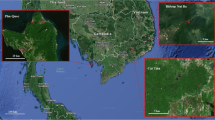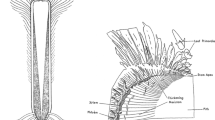Abstract
The abundance of epiphytes is a characteristic feature of the rich vegetation of the wet tropics. Among the epiphytic vascular plants ferns are quite frequent (Chaps. 2, 3 and 9). According to Holtum (1969), about half of the some 500 known fern species in Malaysia are epiphytes. Recently the ecophysiological problems linked with epiphytism are gaining increasing interest from plant scientists (Lüttge 1985; Lüttge et al. 1986a). It is the aim of this chapter to contribute to a better understanding of the ecophysiological implications of epiphytism in ferns. We will discuss recent results obtained by investigations in the laboratory as well as some in situ studies on tropical epiphytic ferns growing in their natural stands in Singapore.
Access this chapter
Tax calculation will be finalised at checkout
Purchases are for personal use only
Preview
Unable to display preview. Download preview PDF.
Similar content being viewed by others
References
Black CK (1973) Photosynthetic carbon fixation in relation to net C02 uptake. Annu Rev Plant Physiol 24:253–286
Griffiths H, Lüttge U. Stimmel KH, Crook CE, Griffiths NM, Smith JAC (1986) Comparative ecophysiology of CAM and C, bromeliads. III. Environmental influences on C02 assimilation and transpiration. Plant Cell Environ 9:385–393
Griffiths H, Smith JAC, Lüttge U, Popp M, Cram WJ, Diaz M, Lee HSJ, Medina E, Schafer C, Stimmel KH (1989) Ecophysiology of xerophytic and halophytic vegetation of a coastal alluvial plain in northern Venezuela. IV. Tillandsia flexuosa Sw. and Schomburgkia humboldtiana
Reichb, epiphytic CAM plants. New Phytol. 111:273–283
Hew CS, Wong YS (1974) Photosynthesis and respiration of ferns in relation to their habitat. Am Fern J 64:40–48
Holtum RE (1969) Plant life in Malaya. Longman, Singapore
Keeley JE, Walker CM, Mathews RP (1983) Crassulacean acid metabolism in Isoetes bolanderi in high elevation oligotrophic lakes. Oecologia 58:63–69
Kluge M, Ting IP (1978) Crassulacean acid metabolism. Analysis of an ecological adaptation. Ecological Studies Vol. 30, Springer, Berlin Heidelberg New York
Kluge M, Friemert V, Ong BC, Brulfert J, Goh CJ (1989) In situ studies of crassulacean acid metabolism in Drymoglossum piloselloides, an epiphytic fern of the humid tropics. J Exp Bot 40 (in press)
Lange OL, Medina E (1979) Stomata of the CAM plant Tillandsia recurvata respond directly to humidity. Oecologia 40:357–363
Lerman JC (1975) How to interpret variations in the carbon isotope ratio of plants:biologic and environmental effects. In:Marcelle R (ed) Environmental and biological control of photosynthesis. Dr. W. Junk by Publishers, The Hague, pp 323–336
Lüttge U (1985) Epiphyten:Evolution und Okophysiologie. Naturwissenschaften 72:557–566
Lüttge U (1987) Carbon dioxide and water demand:crassulacean acid metabolism (CAM), a versatile ecological adaptation exemplifying the need for integration in ecophysiologieal work. New Phytol 106:593–629
Lüttge U, Nobel PS (1984) Day-night variations in malate concentration, osmotic pressure, and hydrostatic pressure in Cereus validus. Plant Physiol 75:804–807
Lüttge U, Stimmel KH, Smith JAC, Griffiths H (1986a) Comparative ecophysiology of CAM and C3 bromeliads. II. Field measurements of gas exchange of CAM bromeliads in the humid tropics. Plant Cell Environ 9:377–383
Lüttge U, Ball E, Kluge M, Ong BL (1986b) Photosynthetic light requirements of various tropical vascular epiphytes. Physiol Veg 24:305–414
Martin CE, Highley M, Wei-Zhong W (1988) The ecophysiological significance of C02 recycling via crassulacean acid metabolism in Talinum calycinum Engelm. (Portulacaceae). Plant Physiol 86:562–568
Nobel PS (1983) Biophysical plant physiology and ecology. WH Freeman, San Francisco Ong BL (1986) A comparative study on the crassulacean acid metabolism in two tropical, epiphytic ferns:Drymoglossum piloselloides (L) Presl. and Pyrrosia longifolia (Burm) Morton. Doctor Thesis, Technical University Darmstadt (FRG )
Ong BL, Kluge M, Friemert V (1986) Crassulacean acid metabolism in the epiphytic ferns Drymoglossum piloselloides and Pyrrosia longifolia:studies on the responses to environmental signals. Plant Cell Environ 9:547–557
Osmond CB (1978) Crassulacean acid metabolism:a curiosity in context. Annu Rev Plant Physiol 29:379–414
Osmond CB, Holtum JAM (1981) Crassulacean acid metabolism. In:Stumpf PK, Cohn EE (eds) The biochemistry of plants, Vol. 8. Academic Press, New York
Popp M, Kramer D, Lee H, Diaz M, Ziegler H, Lüttge U (1987) Crassulacean acid metabolism in tropical dicotyledonous trees of the genus Clusia. Trees 1:238–247
Schimper AFW (1888) Botanische Mitteilungen aus den Tropen. I I. Epiphytische Vegetation Amerikas. Fischer, Jena
Schulze ED, Hall HE, Lange OL, Walz H (1982) A portable steady-state porometer for measuring the carbon dioxide and water vapour exchanges of leaves under natural conditions. Oecologia 53:141–145
Sinclair R (1983a) Water relations in tropical epiphytes:relationships between stomatal resistance, relative water content and the components of water potential. J Exp Bot 34:1652–1663
Sinclair R (1983b) Water relations in tropical epiphytes:performance during droughting. J Exp Bot 34:1664–1675
Smith JAC, Lüttge U (1985) Day-night changes in leaf water relations associated with the rhythm of crassulacean acid metabolism in Kalanchoe daigremontiana. Planta 163:272–283
Smith JAC, Griffiths H, Lüttge U (1986a) Comparative ecophysiology of CAM and Q bromeliads. I. The ecology of the Bromeliaceae in Trinidad. Plant Cell Environ 9:359–376
Smith JAC, Griffiths H, Lüttge U, Crook CE, Griffiths NM, Stimmel KH (1986b) Comparative ecophysiology of CAM and C3 bromeliads. IV. Plant water relations. Plant Cell Environ 9:395–410
Sternberg O, Deniro MJ, Ting IP (1984) Carbon, hydrogen, and oxygen isotope ratios of cellulose from plants having intermediary photosynthetic modes. Plant Physiol 74:104–107
von Willert DJ, Brinckmann E (1985) Kohlenstoff- und Wasserhaushalte von Sukkulenten arider Gebiete. Ber Dtsch Bot Ges 98:455–464
von Willert DJ, Brinckmann E, Scheitler B, Eller BM (1985) Availability of water controls crassulacean acid metabolism in succulents of the Richtersveld (Namib Desert South Africa) Planta 164:44–55
Winter K (1985) Crassulacean acid metabolism. In:Barber J, Baker R (eds) Photosynthetic mechanisms and the environment. Elsevier, Amsterdam, pp 329–378
Winter K, Wallace BJ, Stocker GC, Rocksandic Z (1983) Crassulacean acid metabolism in Australian vascular epiphytes and some related species. Oecologia 57:129–141
Winter K, Osmond CB, Hubick KT (1986a) Crassulacean acid metabolism in the shade. Studies on the epiphytic fern, Pyrrosia longifolia, and other rain forest species from Australia. Oecologia 68:224–230
Winter K, Schroppel-Meier G, Caldwell MM (1986b) Respiratory CO., as carbon source for nocturnal acid synthesis at high temperatures in three species exhibiting crassulacean acid metabolism. Plant Physiol 8:390–394
Wong YS, Hew CS (1976) Diffusive resistance, titratable acidity, and C02 fixation in two tropical epiphytic ferns. Am Fern J 66:121–124
Author information
Authors and Affiliations
Editor information
Editors and Affiliations
Rights and permissions
Copyright information
© 1989 Springer-Verlag Berlin Heidelberg
About this chapter
Cite this chapter
Kluge, M., Avadhani, P.N., Goh, C.J. (1989). Gas Exchange and Water Relations in Epiphytic Tropical Ferns. In: Lüttge, U. (eds) Vascular Plants as Epiphytes. Ecological Studies, vol 76. Springer, Berlin, Heidelberg. https://doi.org/10.1007/978-3-642-74465-5_4
Download citation
DOI: https://doi.org/10.1007/978-3-642-74465-5_4
Publisher Name: Springer, Berlin, Heidelberg
Print ISBN: 978-3-642-74467-9
Online ISBN: 978-3-642-74465-5
eBook Packages: Springer Book Archive




